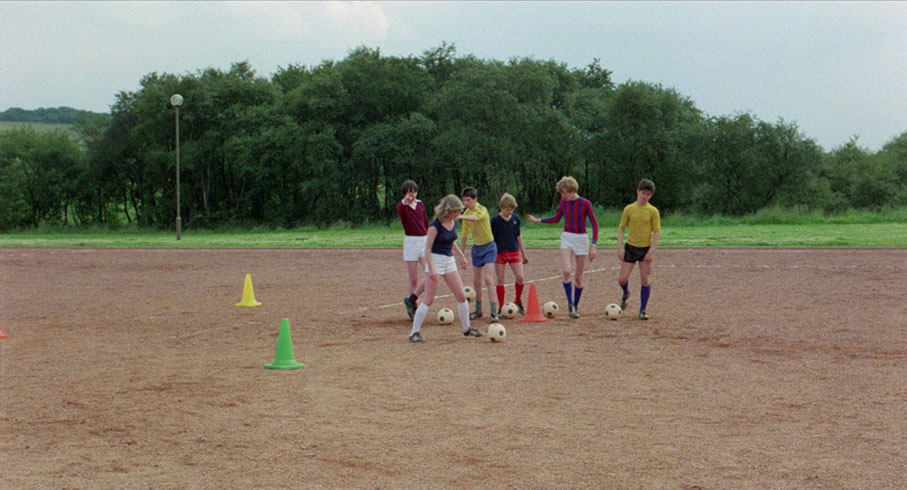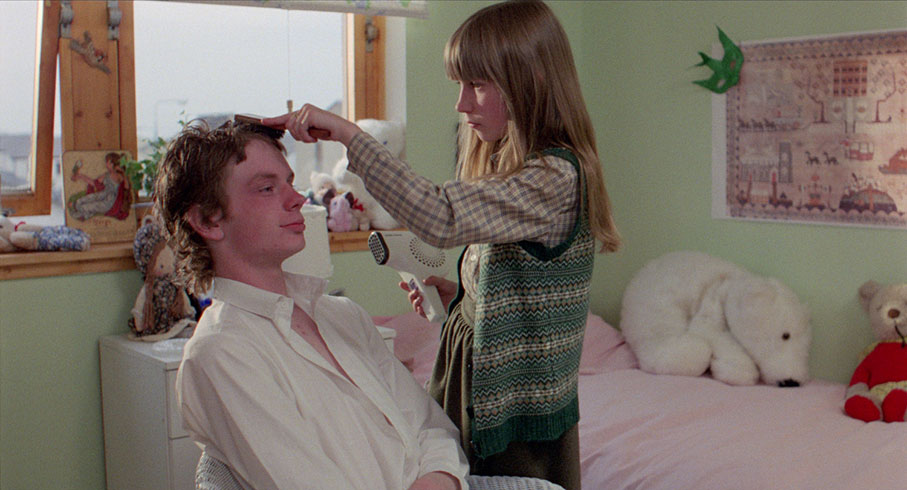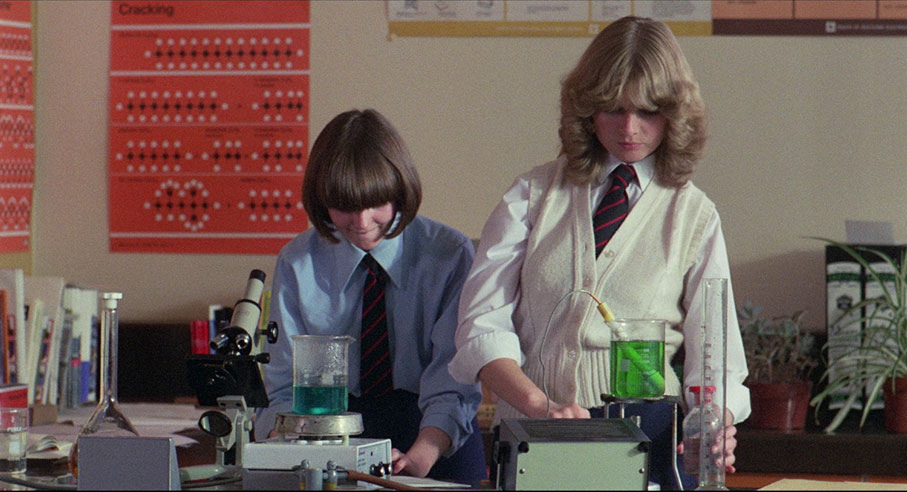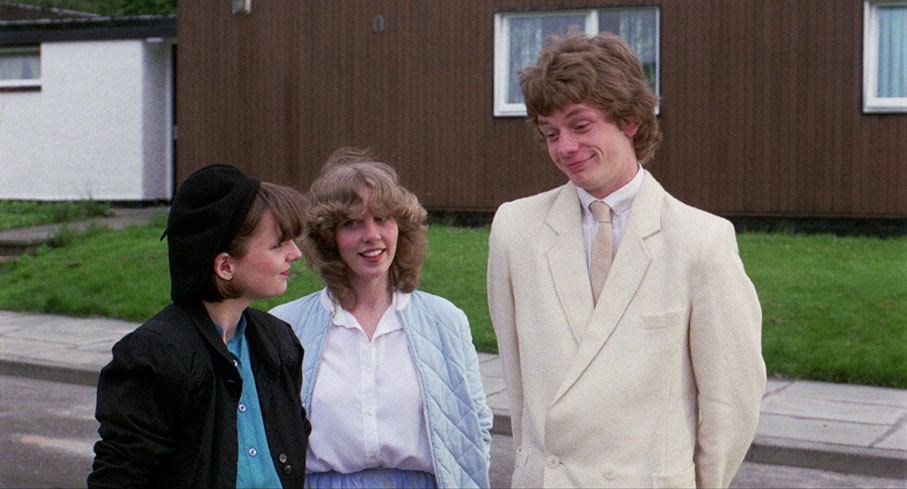|
Gregory (John Gordon Sinclair, billed here as Gordon John Sinclair) is in the fourth form at school, tall and awkward. He's part of the football team which is suffering because it and he aren't very good. The coach sets up trials for new talent and Dorothy (Dee Hepburn) arrives...and is a better player than anyone else. Gregory is immediately smitten.
It's now over four decades since Gregory's Girl came out and it remains a fresh and funny romantic comedy, shot through with a melancholy which had become characteristic of its writer/director Bill Forsyth. It's more of a pity that while Forsyth has been able to follow it up – plenty would call his next feature, Local Hero, his best work – he hasn't made a film since 1999. After its original release, back in the days before widespread home video, it had a second bit of the cherry in being reissued in cinemas on a double bill with Chariots of Fire, which is when I first saw both films.
Bill Forsyth's first feature, That Sinking Feeling (1979), shot in Glasgow using members of the local Youth Theatre, was at the time in the Guinness Book of Records as the lowest-budget film ever to receive a commercial cinema release. Gregory's Girl was a step up in scale, though still very modest: shot in 35mm instead of 16mm (by the same DP, Michael Coulter, who had got the original gig because he had his own camera), on location in the Scottish New Town of Cumbernauld, and using many of the same cast. It was produced by Davina Belling and Clive Parsons, who had previously made Scum and Breaking Glass.

Nearly four and a half decades later, despite its Best Picture Oscar and its screenwriter's boast that "The British are coming!", Chariots of Fire seems to be more or less fading into the past. On the other hand, Gregory's Girl remains fresh and funny. If it has dated, it's only in superficial ways, the usual pre-mid-90s indicators of no mobile phones – one plot point is enabled by means of a public payphone – and no Internet or social media, and it's true it might be made differently today. But it remains a low-key character comedy that is still relevant, while tall, gangling awkward boys still make clumsy attempts to meet girls and while there are still adolescent growing pains. Forsyth drew inspiration from Ealing and the films of Jacques Tati, which he'd seen in school, and scenes and dialogue from this film have passed into the culture. Even such standard romantic-comedy tropes as Gregory's younger sister Madeline (Allison Forster, her only screen role – a different actress played the character in the sequel) being more worldly-wise than her brother and advising him, don't seem rote. (In the commentary, Forsyth says he lifted this from The Catcher in the Rye.) You could add that the most level-headed characters in the film are the youngest ones, with the few adults (other than Gregory's Dad, mostly teachers) being the more childish. As always, it's in the writing (by Forsyth): even minor characters such as those teachers get well-scripted scenes that make them come to life, even in the short time they're on screen. Also, he feels out the story with quirky details such as the unexplained man in the penguin suit (played by Christopher Higson, now a carpenter working for Peter Jackson).
Gregory's Girl is based on a premise that was certainly progressive – a teenage girl playing football in a boys' team – and, given debates about the visibility of women's sports, it still is. In fact, with women's football having a far higher profile nowadays, with England's Lionesses winning the Euros and reaching the finals of the World Cup, it's more timely than ever. You can imagine – or dread – a Hollywood version of this overtly sexualising Dorothy, Susan and the other girls. But that's not the case here: Gregory's attraction to Dorothy is sparked by her footballing prowess. And, throughout the film, the girls are far more aware and mature than the boys, and it's the girls who resolve the film in its final act, with Gregory not having a clue what's going on. Dee Hepburn plays Dorothy with a sense of amused detachment that might seem supercilious in a less sympathetic character: you're aware she knows exactly what's going on.
John Gordon-Sinclair had a small role in That Sinking Feeling, fitting in the filming around his Highers exams. Clare Grogan was just becoming a pop star as lead singer with Altered Images around the time of Gregory's Girl. She is filmed almost entirely from her right side, to hide scars received from broken glass while fleeing a Glaswegian pub brawl. Both worked with Forsyth again, and both continue to act to this day. Dee Hepburn had had some previous acting experience – one episode of the television series The Prime of Miss Jean Brodie, billed as Dory Hepburn (from her actual given name of Doreen). She has however not continued an acting career: her only later credits were in episodes of the TV series Maggie and Crossroads and the 1996 film, The Bruce. She received coaching from Partick Thistle for her character's footballing skills, and that may explain Gregory having a poster for that team on his bedroom wall, along with the likes of Rush, The Specials and Patti Smith (actor's own posters). Robert Buchanan, the lead in That Sinking Feeling, is effective as Gregory's best friend Andy.

Gregory's Girl had a US release (with a redubbed soundtrack, see below). Oscar paid no attention, but BAFTA nominated it for Best Film and Best Director with Forsyth winning for his screenplay. He made a sequel, Gregory's 2 Girls, in 1999, which was his last film to date.
Gregory's Girl is released by the BFI in UHD and Blu-ray editions. This is a review of the latter, the disc encoded for Region B only. The transfer begins at chapter two, but go back from there and you'll see the original green A certificate, instant nostalgia for those of us of a certain age. That's the equivalent of today's PG, but due to some some moderate language and an opening scene where several boys spy on a student nurse getting undressed in her room, Gregory's Girl now has a 12 certificate.
The film was shot in 35mm and the transfer is in the intended ratio of 1.85:1. This was never visually the most slick of films, due mainly to the small budget, and much of it has a natural-light look, which as this is Scotland is not always especially bright, even in the summer when this was shot. However, the transfer does look the way the film has always looked. Grain is present, but is natural and filmlike.
The soundtrack is the original mono, rendered as LPCM 2.0. It's clear and the dialogue, music score and sound effects are properly balanced. If, however, you have problems with the Scottish accents on display, there are two options. The first are English hard-of-hearing subtitles. The second, accessible via the special features menu or scrolling through audio tracks on your remote, is a second original soundtrack: a redub (the "Edinburgh Version", Forsyth calls it) for the film's US release. This tones down some of the stronger Scottish accents, and has a noticeable difference in ambience. There are a few changes of dialect and idiom: "windaes" becomes "windows", the line "tits, bum, fanny, the lot" becomes "tits, bum, panties, the lot" and Eric's line that in the future there will be no men and women, just people, and "a world full of wankers" becomes "a world full of whack-offs".
English subtitles are available for the hard-of-hearing but render only the original version, so windaes, fannies and wankers are present and correct. The English hard-of-hearing subtitles provide the original version's dialogue.
Commentary with Bill Forsyth and Mark Kermode
Recorded for a previous (2014) Blu-ray and DVD release of Gregory's Girl, Bill Forsyth, talks to Mark Kermode, a big fan of the film and of Forsyth's work. However, Kermode steers the conversation clear of too much of a love-in and the result is an interesting if not over-detailed chat concerning a film Forsyth is proud of, though he acknowledges its flaws – an unduly slow pace, for one.
Commentary with Robert Buchanan, Douglas Sannachan, Caroline Guthrie and Douglas Weir
Newly recorded for this Blu-ray release, the BFI's Douglas Weir moderates a conversation between three of the supporting cast. This isn't especially scene-specific, given that the three's onscreen time is limited. Buchanan is onscreen the most, and tends to talk the most, and has more anecdotes about Bill Forsyth as he played the lead in That Sinking Feeling. Otherwise, the chat does wander into other areas, such as the possible influence of Bill Forsyth on Wes Anderson, and much about Glasgow Youth Theatre's founder John Baraldi, who is thanked in the end credits. Guthrie reveals that the shot in which she appears towards the end of the film features legs other than her own. Weir sets the three (and us) a question: although the film was shot in Cumbernauld, what is the name of the (fictional) new town where it takes place? Watch to the very end of the film to find out...

Q&A (30:28)
This took place in 2015, after a showing of Gregory's Girl to mark its thirty-fifth anniversary. The film was shown as part of a Love season at the BFI Southbank. Featured are John Gordon Sinclair, Dee Hepburn and Clare Grogan, interviewed by Sue Harris. Inevitably, as she is interviewed elsewhere on this disc, there is some overlap with Clare Grogan's interview, and you can guess the Eighties reference when she tells how she met Forsyth when she was working as a waitress – except it's Sinclair who completes her sentence for her. On the other hand, this is the only contribution by both Sinclair and Hepburn to the extras, and Hepburn was rather lower-profile after the film than the others. (She left acting in the late 1990s, while at the time of this interview the other two were still in the profession, and in Grogan's case in music as well.) It's clear that all three look well on the film they made when they were all still teenagers. They are asked about it to this day, and often get lines of dialogue quoted at them. In Sinclair's case that's inevitably "Bella, bella…" Questions from the audience appear as text captions.
Bill Forsyth: The Early Years (20:58)
Also from 2014, Forsyth talks to camera. As he reveals, he had little interest in film early on, but developed one when he got a job with a film company after school, and started watching films in earnest, mostly arthouse rather than commercial material. He then moved into making documentaries, and actually wrote the first draft of Gregory's Girl before making That Sinking Feeling. Making two films with young people was a calculated move: both to keep the budget down and also to gain experience in working with actors as they were similarly at the beginnings of their career. That Sinking Feeling was made first, when financing for Gregory's Girl fell through. (The BFI turned down Gregory's Girl on the grounds that it was too commercial, and you can see why it would have been an odd fit for the films the BFI was making at the time.) Following That Sinking Feeling, Forsyth was approached by Belling and Parsons, and the film was made for about ten times the budget he had failed to find previously. Inevitably, some of this overlaps with Forsyth's commentary with Mark Kermode.
Clare Grogan interview (11:32)
Another item carried forward from 2014. Clare Grogan met Forsyth when she was working as a waitress (cue the Human League reference) in a restaurant called the Spaghetti Factory, where he was a regular customer. He offered her the role in Gregory's Girl then, and she went on the play the role just after leaving school. Her "dance" sequence with Sinclair was Forsyth's idea, but improvised by the two of them on location. Her parallel career as a pop star – as lead singer with Altered Images – was underway when she made the film and was taking off when it was released, and the publicity certainly helped.
The Strathclyde Tapes (38:21)
A video recording from 1992, this is a variation on the BBC programme from around the same time called Open to Question, where a public figure answers queries from a group of young people. In this case, Bill Forsyth's trial by sixth former is gentler than some of these gatherings have been, as he is asked about his writing and filmmaking process and the possibilities of filmmaking in Scotland if not an actual industry north of the border.
Soundtrack gallery (13:22)
This is a variation on the usual stills gallery, a self-navigating succession of images (publicity stills in black and white and colour, front of house cards, posters) with nineteen cues from Colin Tully's music score playing on the soundtrack.

US trailer (3:04)
A rather lengthy trailer, which usually indicates that they weren't entirely sure how to sell this film, and it relates almost all of the film's plot until fairly close to the end.
Booklet
The BFI's booklet, available with the first pressing only, runs to twenty-six pages. It begins with a spoiler warning for some of the contents, then the main essay, "Gregory's Girl: Tits, Bum, Fanny – The Lot" by Tim Blanchard, author of a book on the film. This takes for granted the film's ongoing fandom – "we all know someone who loves Gregory's Girl" – but I'm not about to quibble with that. Blanchard takes account of the film's place in the Scottish film industry, with it mostly previously been dominated by television and documentary work. Following That Sinking Feeling, the success of Forsyth's film enabled films in a similar vein to be made (Restless Natives and The Girl in the Picture, for example) and later others which decidedly weren't, such as Trainspotting and debut features from other Scots such as Orphans and Ratcatcher. However, following Local Hero, Forsyth found himself in the Hollywood studio system, with mixed results. Blanchard traces Forsyth's beginnings as a filmmaker, of feature films at least, as due to his business partner Charles Gormley and John Baraldi of the Glasgow Youth Theatre. This essay is more about the place of Gregory's Girl in Forsyth's career and Scottish cinema in general than one about the making of the film itself.
For some of that, you have "Caracas etc" by David Archibald. He traces Forsyth's early career, working as a production assistant from 1964 and working in documentary with the aforementioned Charles Gormley. Archibald notes the irony of writing an essay for a BFI release of Gregory's Girl when the same organisation turned it down originally. He continues in talking about the film's look at masculinity, sometimes of the potentially toxic kind, such as the voyeurism of the opening scene and the adult teachers' comments about some of their charges, things which darken a little what remains a charming comedy. Of course, the men are more fools than the boys and the ones which really have things sorted are the girls. Archibald then looks at Forsyth's later career, beginning with the BBC fifty-minuter Andrina, from a story by Orcadian writer George Mackay Brown, shown so far just once, in 1981. This was followed by work in the USA, with Housekeeping (1987), Breaking In (1989) and the ill-fated Being Human (1994) before a final return to the well with Gregory's 2 Girls.
Next up is "Creating an Industry: Glasgow Youth Theatre to Gregory's Girl" by Claire Walker. As the title suggests, this tells the story of the GYT and Forsyth's involvement with it, with That Sinking Feeling made when money for Gregory's Girl was not forthcoming, and then the latter film on the back of the former's success. This essay is dedicated to the memory of John Baraldi, who died in 2023.
A full cast and credits list is followed by Gilbert Adair's original 1981 review from Sight & Sound, and notes on and credits for the extras.
Over forty years on, Gregory's Girl stands up very well. Although it's very clearly of its time in many ways, you sense it will still appeal to younger viewers as well as nostalgic adults, as its themes don't date, just the details do. It's well presented on this BFI release.
|